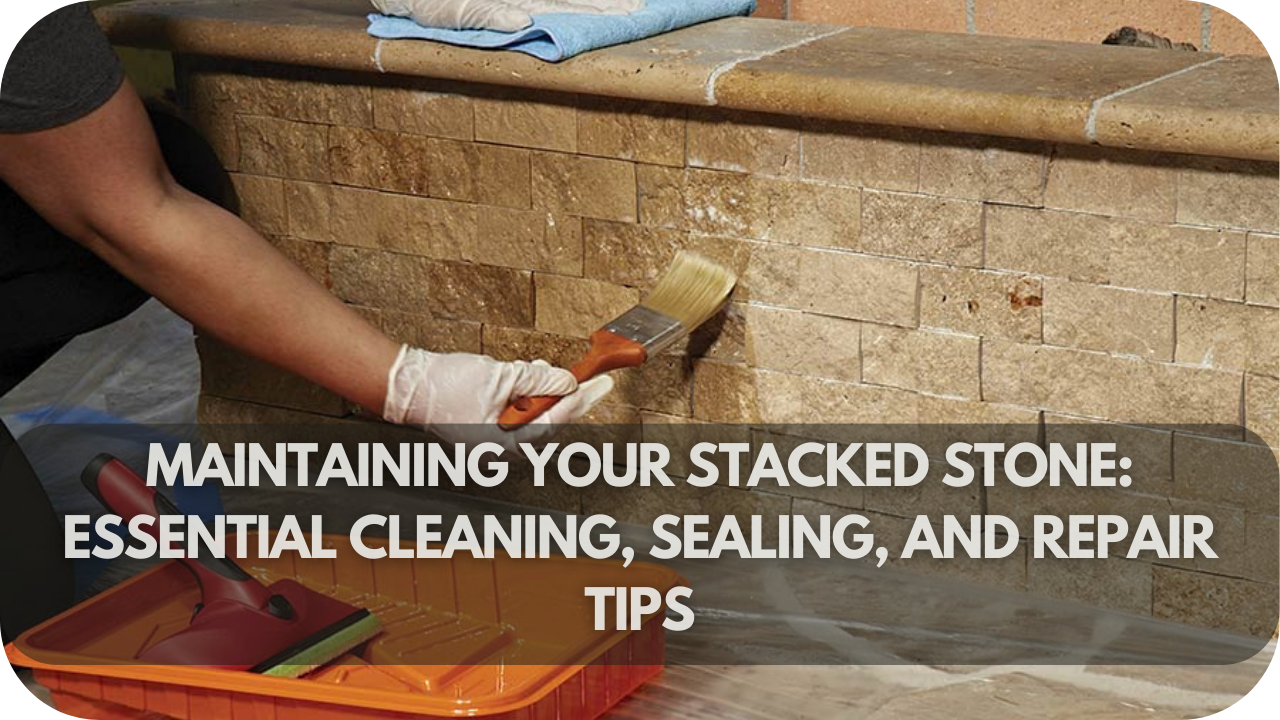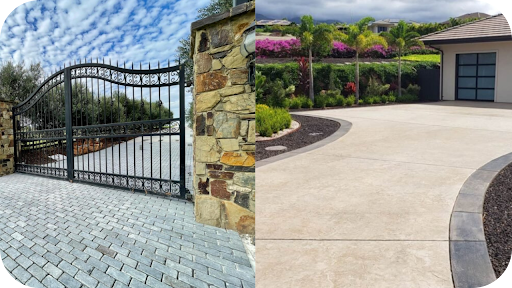
Stacked stone features bring a natural charm to any space, whether indoors or outdoors. Their rustic elegance can transform walls, fireplaces, and landscaping into stunning focal points. However, these stones are not maintenance-free.
Without proper care, dirt, stains, and moisture can diminish their beauty and lead to damage over time. The good news is that with regular upkeep, you can protect your investment.
This guide provides simple steps for cleaning, sealing, and repairing stacked stone, ensuring it stays strong and beautiful for years.
Routine Cleaning
Keeping your stacked stone clean is the first step to preserving its beauty and durability. Dust, dirt, and other debris can accumulate on the surface, dulling its appearance. A simple daily or weekly cleaning routine can prevent this buildup and protect the stone’s natural texture.
For daily care, use a soft-bristled brush or a dry microfiber cloth to gently dust the surface. This removes loose dirt and debris without causing scratches or unnecessary wear.
Weekly cleaning may involve a bit more effort. Use a damp cloth or sponge with warm water to wipe down the stone. For deeper cleaning, choose a pH-neutral cleaner specifically designed for natural stone.
These cleaners effectively remove dirt without harming the stone’s surface. Avoid using acidic or harsh cleaners like vinegar, bleach, or ammonia, as they can etch the stone and cause permanent damage.
When cleaning, always use soft tools like sponges or non-abrasive cloths. Harsh scrubbers or wire brushes can scratch or chip the stone. After cleaning with water, immediately dry the surface with a clean towel to prevent water spots or moisture-related issues.
Consistent routine cleaning not only keeps the stone looking its best but also reduces the likelihood of long-term damage.
Deep Cleaning Tips
Even with regular cleaning, dirt and stains can settle deeper into stacked stone, especially in high-traffic or outdoor areas. Deep cleaning is essential to restore its natural beauty and remove stubborn buildup. Here’s how you can deep clean your stacked stone effectively:
- Frequency of Deep Cleaning: Perform deep cleaning once or twice a year, depending on the level of dirt, moisture, and stains the stone is exposed to.
- Preparation: Pre-wet the stone with plain water to prevent it from absorbing cleaning solutions too quickly. This step minimises the risk of discolouration.
- Cleaning Solution: Use a pH-neutral stone cleaner to loosen dirt and stains. Let the cleaner sit for a few minutes to work effectively. For tougher stains, like mould or mildew, mix a solution of half a cup of ammonia with one gallon of water. Use this sparingly. Always test the cleaning solution on a small, hidden area first to ensure it won’t harm the stone.
- Cleaning Process: Gently scrub the stained areas using a soft-bristled brush. Avoid stiff brushes or abrasive tools, which can scratch the surface. Rinse thoroughly with clean water to remove all traces of the cleaning solution.
- Final Steps: Immediately dry the stone with a soft cloth to prevent water spots or lingering moisture.
- Consider Commercial Products: While DIY solutions are convenient, commercial stone cleaners often yield better long-term results.
Sealing Stacked Stone
Sealing your stacked stone is one of the most effective ways to protect it from damage caused by moisture, stains, and weather exposure. It also helps maintain the stone’s natural texture and appearance.
Choose a sealant specifically formulated for natural stone. Silicone-based sealants are ideal for exterior applications due to their durability and water resistance, while water-based sealants work well indoors. Ensure the product won’t change the stone’s natural colour or finish.
Before sealing, clean the stone thoroughly and let it dry completely. Any dirt or moisture left behind can interfere with the sealant’s adhesion and effectiveness. Apply the sealant using a sprayer, roller, or brush, working evenly across the surface. Start from the top and move downward to prevent drips on areas you’ve already sealed.
Once the sealant is applied, allow it to cure for the time recommended by the manufacturer, typically 24 to 48 hours. During this period, avoid touching or using the stone. Reapply sealant every two to five years, depending on the level of wear and exposure.
Regular sealing not only enhances the stone’s durability but also keeps it looking fresh and well-maintained.
Repairing Damaged Stacked Stone
Over time, cracks, loose stones, and mortar gaps can appear in stacked stone installations. Addressing these issues quickly is vital to prevent further damage and maintain the structure’s strength and appearance. Follow these steps for effective repairs:
- Inspect the Damage: Look for loose stones, cracks, or eroded mortar. A thorough inspection ensures no problem goes unnoticed.
- Prepare the Area: Clean the damaged area to remove debris, dust, and old mortar that could weaken the repair.
- Remove Loose Stones: If stones are loose or have fallen out, carefully remove them. Clean off any remaining mortar for a smooth reapplication.
- Mix Fresh Mortar: Prepare a new batch of mortar, matching the existing material in colour and texture. Use type S mortar for its strong adhesive properties.
- Reapply the Stones: Apply the mortar to the back of the stone and the surface where it will be placed. Press the stone firmly into position, aligning it with surrounding pieces for a seamless look.
- Fill Gaps: Use a pointing tool to fill gaps in the mortar joints. This step prevents water infiltration and strengthens the structure.
- Cure the Mortar: Allow the mortar to cure according to the manufacturer’s instructions, usually 24–48 hours.
- Seal the Repaired Area: After curing, apply a sealant to protect the new mortar and surrounding stones from moisture and future damage.
Preventative Measures
Prevention is better than cure when it comes to maintaining stacked stones. With simple, proactive steps, you can avoid common issues like cracks, moisture damage, and structural wear.
Inspect your stacked stone twice a year, looking for signs of damage such as loose stones, eroded mortar, or small cracks. Addressing minor issues early prevents them from becoming bigger, costlier problems.
Keep your stone properly sealed to protect it from water penetration, stains, and weathering. Reapply sealant every few years, depending on the stone’s exposure to the elements. Regular sealing minimises the risk of damage and reduces maintenance needs.
Ensure proper drainage around stacked stone installations to prevent water from pooling near the structure. Moisture is a leading cause of damage, promoting mould growth and weakening mortar. Direct water away using gutters and downspouts.
Avoid using harsh cleaning methods like high-pressure washing, which can erode mortar and damage the stone. Instead, clean gently with mild soap and a soft brush. Additionally, keep vegetation like vines and heavy plants trimmed away from stone surfaces to prevent root damage.
These preventative measures are simple but effective. They’ll help maintain your stacked stone’s beauty and strength, reducing the need for extensive repairs.
Conclusion
Proper care keeps stacked stone beautiful and durable for years. Regular cleaning, timely repairs, and sealing are essential to prevent damage and maintain its charm. Don’t wait for issues to arise—start your maintenance routine today to protect your investment. If you’re unsure about the right products or techniques, consult a professional for tailored advice.
If you need professional advice or the right products for your stone care needs, reach out to Splendour in Stone. Let us help you preserve the timeless elegance of your stacked stone!
More To Explore

How to Achieve a Rustic Farmhouse Style with Reclaimed Bricks
Many homeowners want the charm of a rustic farmhouse but struggle to make it feel authentic. Modern materials often look too uniform, leaving spaces without

Comparing Natural Stone and Concrete for Outdoor Projects
Choosing the right surface for your outdoor space is more important than it seems. Pick the wrong material and you could face early wear, fading,


